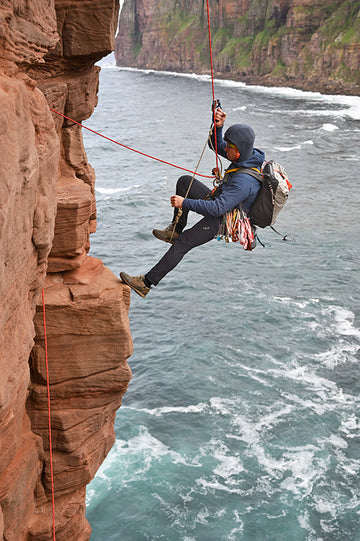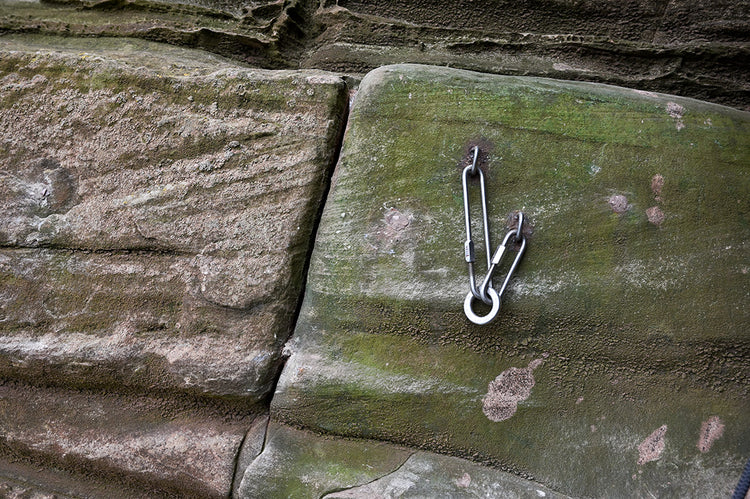Leave no trace or at least having a minimum impact is a practice you’d hope most climbers would view as second nature. However, sea stacks make this a challenge. You need to get back down and inevitably gear needs to be left behind; rope and slings if natural anchors are available or hardware if there are only cracks.
Staring at the spider’s web of rotting tat and rusting bolts, pegs, carabiners, and nuts in places on the Old Man of Hoy this is clearly an issue. The harsh marine environment isn’t kind to in-situ kit. It’s easy to see how this mess comes about. Over the years, as teams descend, unable to judge the strength of discoloured abseil slings and corroded wires, they’ll often add to it as a back-up for the abseil anchor.


It was this that started the discussion earlier this year about cleaning-up the stack and adding a more sustainable solution at a couple of the abseil stations. Considered the tallest sea-stack in the UK, the 137 metre (450 ft) Old Man of Hoy, rises off the west coast of Hoy, one of the Orkney islands, and epitomises adventurous UK trad climbing.
It has also had a place in the wider public consciousness since a third of the population (15 million people) watched a BBC live broadcast in July 1967 of Bonington and Patey repeating their original East Face route, while Joe Brown and Ian McNaught-Davis, and Pete Crew and Dougal Haston climbed two new lines. An early forerunner of reality TV. Plenty of old bolts from that broadcast are still obvious.


The Old Man is now part of the Hoy nature reserve overseen by the RSPB, a SSSI and features strongly in the cultural history of Hoy.
Over the last weekend of September, Sam Percival assembled a team of six Association of Mountaineering Instructors (AMI) to undertake a clean-up of the stack and rationalise the abseil stations. Stuart Holmes, having a good technical knowledge of placing fixed gear, joined them.
Earlier in the summer a climber posting as Malcolm, on the UK Climbing website, said that he had cleaned up 40 kg+ of old tat from the stack and left it on the ‘rubble bridge’ connecting it to the mainland, asking for future climbers to carry-out bit-by-bit. As you can see from the photos there was still plenty left in place on the stack for Sam’s team to clean-up. They also removed three cams left behind on the crux pitch and numerous rusting old wires. The wooden wedges on the crux pitch from the first ascent in 1966 were left in place.


At the summit two new independent static rope anchors with protectors and a titanium ring for the descent were installed and at two of the abseil stations a couple of titanium glue-in bolts were placed, doing away with the need to back-up the old bolts and pegs with wires.
The threads at the top of the ‘coffin crack’, and the spectacular 60-metre final abseil, were replaced along with rope protection. Stuart reckoned that the lifespan of the titanium rings and bolts is around 200 years. Who knows, by then the stack may have toppled over.
After the clean-up, Sam commented: “We spoke to the landowners about the project and Hoy warden, Lee Shields, helped with communicating with the RSPB. We planned to do it at the end of the climbing season and obviously when it was free of birds.”




He added: “We’ve reduced the mess on the ledges, and nothing needs discarding further. Birdwatchers don’t want to see a load of ‘rubbish’. Obviously, at some point the rope will need replacing but it should be good for a while now.”
“The problem has been people discarding gear that rapidly degrades, and the next person doesn’t know if it’s safe. There’s an abseil station at the base of the final corner pitch and another before the top of the crux pitch, so I recommend four abseils in total with 60 metre ropes. It’s cleaner, both visually and materially, no rotting slings, minimal metalwork and simpler in descent.”
Words and photos: © Ray Wood






